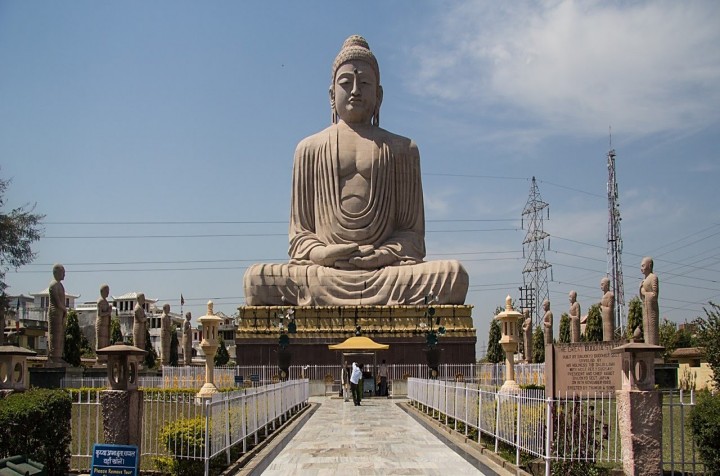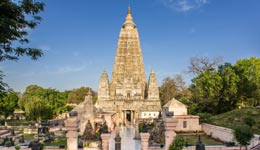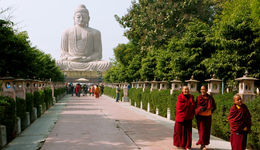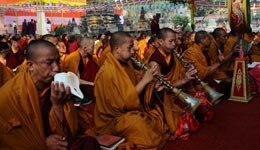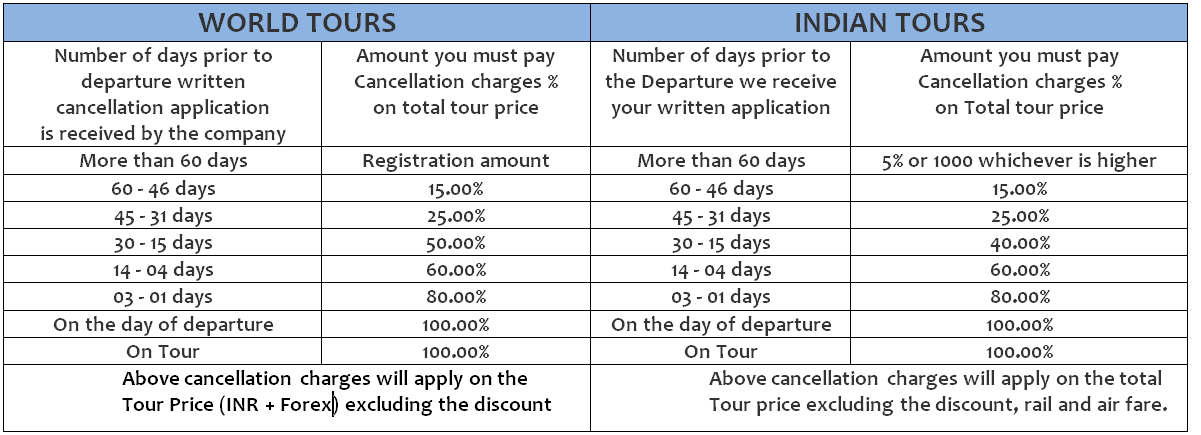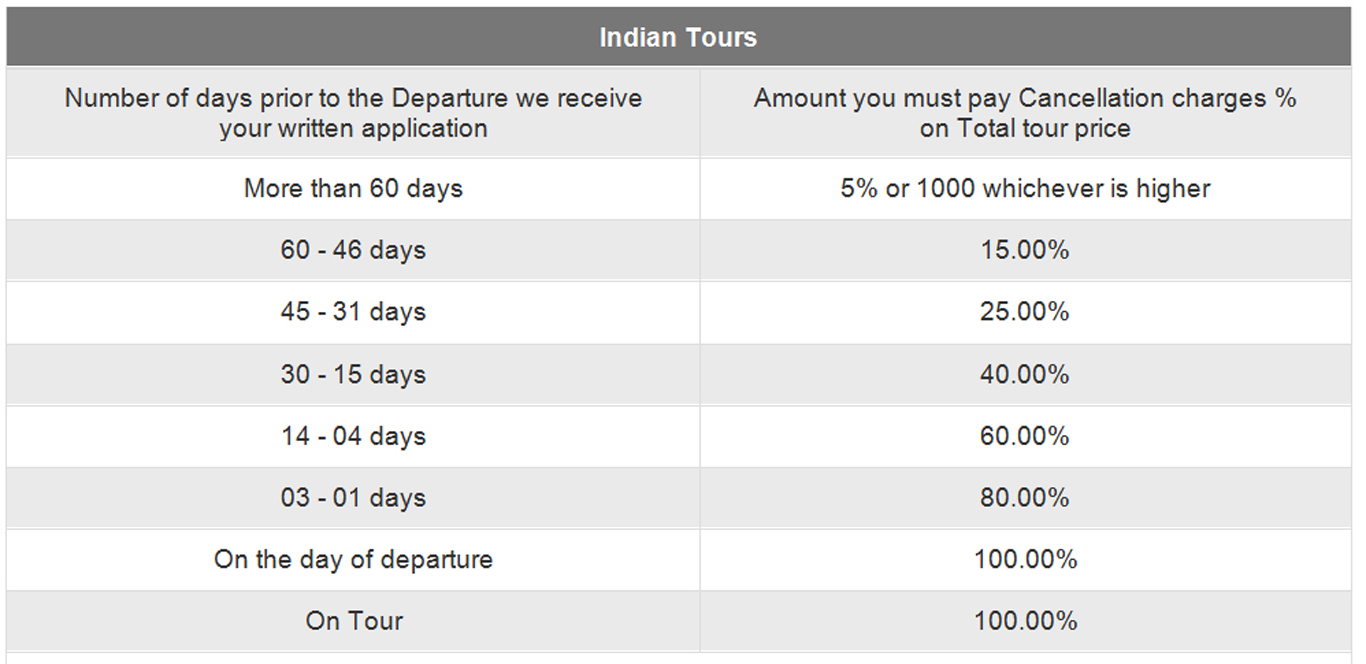Description
APNA BIHAR
Set on the banks of the holy river Ganga, Bihar state shares its borders with Orissa, West Bengal, Nepal and Uttar Pradesh. A well-known religious center for Hindus, Jains and Buddhists, Bihar is one of the most popular travel destinations in India.
The state was once ruled over by great empires, which is why it today reflects a glorious past. Bihar is dotted with a number of Buddhist Monasteries and historical monuments.
Some major travel destinations of Bihar are Bodhgaya, Nalanda, Rajgir, Patna, Vaishali, Vikramshila and Pawapuri. All these destinations are known for housing famous pilgrimage sites.
Bihar is home to many tourist attractions like Harminder Sahib, State Museum, Sher Shah's mausoleum, Sanjay Gandhi Zoological Park, Martyr's Memorial, Har Mandir Takht, Pathar ki Masjid, Bihar Institute of Handicraft and Design and Kumhrar Bagh.
Find out more about this beautiful state in this Bihar Travel Guide by TRAVEL OF INDIA.

Bihar is a state in eastern India. It lies on the Gangetic plain, with Uttar Pradesh to its west, West Bengalarching to its south and east, and with Nepal to its north. The Bihar plain is divided into two unequal halves by the river Ganga which flows through the middle from west to east. Bihar is one of India's poorest states, with stark social inequality. Travelers may find the hassles common to traveling everywhere in India are more pronounced here.
Regions[edit]
Bihar can be grouped into four regions based on river boundaries. These four regions have very similar languages - Angika, Bhojpuri, Magadhi and Maithili spoken in respective regions. The languages are collectively known as 'Bihari' and are decedents of the ancient language of Magadhi Prakrit, the language spoken by the Buddha and the language of the ancient kingdom of Magadha.
| Anga | Bhojpur |
| Magadha | Mithila |
Cities[edit]
| Patna — the state capital | Sasaram | Siwan | Bhagalpur — largest city in Anga | Bihar (also known as Bihar-sharif) | Darbhanga — capital of Mithila (cultural capital of Bihar) |
| Gaya | Kaimur — largest city in Bhojpur | Muzaffarpur | Purnia | Rajgir | Munger — Capital city of Anga |
| Bettiah | Motihari |
Other destinations
Bodh Gaya — site of the Buddha Sakyamuni's enlightenment
Nalanda — site of the ruins of an ancient Buddhist university and the Nalanda Multimedia Museum
Valmiki Nagar — national tiger reserve
Sasaram — Tomb of Sher Shah Suri
Understand
Bihar lags behind the other Indian states in social and economic development, and is one of the poorest Indian states. The state doesn't have good infrastructure facilities and so tourists may find their stay and travel very inconvenient. Nevertheless the state have many places to explore like Bodh Gaya (considered to be the birth place of Buddhism) and Nalanda (the site of one of the oldest universities of the world). The reason for the economical backwardness of the state is blamed on the state leadership, the central government's policies like the 'freight equalization policy' and its apathy towards Bihar, a lack of Bihari state pride (resulting in no spokesperson for the state) and the policy of Permanent Settlement by the British East India Company, which has left a feudalistic culture still dragging the state back.
Bihar has a youthful and mainly rural population of 85% and the society is mainly agrarian. Northern Bihar is prone to perennial flooding. The state has seen mass migration out of the state in last few decades and these ethnic Biharis living in other states of India are victims of racist hate crimes and prejudice. There was even Naxal insurgence in last few decades, especially in Southern Bihar, but the situation has calmed down in recent years. The state has earned a very poor image outside Bihar due to a poor law and order situation and involvement of crime in politics, which are generally exaggerated. Jharkhand, the mineral-rich tribal belt, used to be part of the state, but in 2001, it was split to form its own state.
History[edit]
Bihar has a glorious past. Bihar was known as Magadha in ancient times. It was a center of power, learning and culture. The Maurya empire as well as one of the world's greatest pacifist religions, Buddhism, arose from Magadha. Bihari empires, like the Maurya and the Gupta, unified large parts of South Asia under a central rule. Pataliputra (modern Patna), the capital of Magadha, was an important center of Indian civilization. Many important non-religious books like Arthashashtra and Kamasutra were composed here 2000 years back. Vaisali, one of the first known republic, existed here since before the birth of Mahavira (c. 599 BC).
The state suffered immensely due to Hunnic and later Muslim invasions, and the old traditions of culture and learning was almost lost by the end of 12th century. The Muhammad Bin Bakhtiar Khilji in 12th century C.E. destroyed many of the viharas (Buddhist sanghas) and the famed universities of Nalanda and Vikramshila. Thousands of Buddhist monks were massacred. Bihar lost its importance in the medieval period though it rose to prominence for a brief period during the rule of Sher Shah Suri in the 15th century. Foreign invaders often used abandoned viharas as military cantonments. The word Bihar have come from the large number of viharas thus employed in the area. Originally Bihar was name of a town, which was headquarter of the Muslim invaders in Magadha, in the medieval period. The headquarter was later on shifted, from Bihar to Patana (current Patna), by Sher Shah Suri and the establishments in those time started calling Magadha by the name Bihar. The town of Bihar still exists is also known as Bihar-Sharif, which is located in Nalanda District, near the famous ruins of the Nalanda University.
The culture and lifestyle of the Biharis haven't changed much over the centuries. Resurgence in the history of Biharcame during the Indian independence struggle against the British rule.
Get in[edit]
By plane[edit]
Bodh Gaya fields international flights to Bangkok (Thailand) and Paro (Bhutan), catering largely to Buddhist pilgrims. Patna is connected to major Indian cities.Airport at Purnea serves bi-weekly flight to Patna and Kolkata.
Patna-Gaya-Ranchi air taxi service [1].
By train[edit]
Bihar is connected by train to all major cities of India. Some good trains to reach the capital Patna are:
From Delhi - Patna Rajdhani Express(2309/2310), Sampurna Kranti Exp. (overnight journey)
From Kolkata - Jan Shatabdi Exp. ( 8-9 hrs.)
From Mumbai - Rajendra Nagar Lokmanya Tilak T. Exp.
From Varanasi - Vibhuti Exp. (6 hrs.).
From Bangalore - Sanghamitra Express(12296). Travel Time: 48h 25m Distance: 2721 km
By Road
Major National Highways which connect Bihar with other cornor of country are as follows NH 2, 19, 28, 30, 31.
Patna is well conncet by road with all the corner of country, Deluxe bus services are available for following location Ranchi, Jamshedpur, Kolkata, Siliguri & Nepal border.
Get around[edit]
See[edit][add listing]
Bodhgaya Near the holy city of Gaya, the Buddha attained enlightenment. The tree that had sheltered him came to be known as the Bodhi tree and the place Bodhgaya. Today Bodhgaya, an important place of pilgrimage, has a number of monasteries, some of them established by Buddhists of Japan, Thailand, Myanmar, Sri Lanka etc.
Patna once called Patliputra the capital of Bihar, is among the world's oldest capital cities with unbroken history of many centuries as imperial metropolis of the Mauryas and Guptas imperial dynasties.
Nalanda A great centre of Buddhist learning, Nalanda came into prominence around the 5th century BC and was a flourishing university town with over ten thousand scholars and an extensive library.
Rajgir Rajgir,103 kms from Patna, was the ancient capital of Magadha Empire. Lord Buddha often visited the monastery here to meditate and to preach. Rajgir is also a place sacred to the Jains, Since Lord Mahavira spent many years here.
Vaishali Vaishali was one of the earliest republics in the world (6th century BC).It was here that Buddha preached his last sermon. Vaishali, birthplace of Lord Mahavira is also Sacred to Jains.
Kesaria This Stupa is in fact one of the many memorable stupa remarkable event in the life of Buddha. Kesaria has a lofty brick mound capped by a solid brick tower of considerable size, which it self is the remain of a Buddhist Stupa. The mound is a ruin with a diameter of 68 feet at its base and a total height of 5½ ft. originally it was crowned by a pinnacle which must have stood 80 or 90 ft above the ground. General Cunningham dated this monument to AD 200 to 700, and held that it was built upon the ruins of a much older and larger Stupa. It is the highest Stupa found in the country with a height of about 104” from the base.
Pawapuri In Pawapuri, or Apapuri, 38 kilometres from Rajgir and 90 kilometres from Patna, all sins end for a devout Jain. Lord Mahavira, the final tirthankar and founder of Jainism, breathed his last at this place.
Tar (Bhojpur) Situated about 10 kms North West of Piro the village derives its name from Tarka, a she demon killed by lord Rama. There is an old tank in the village that is said to be the wrestling ground of Tarka.
Ahirauli (Buxur) Situated about 5 kms north-east of Buxur, this village has a temple of Devi Ahilya. According to the local tradition it dates back to the pre historic ages. Legend is that, Ahilya was transformed into stone as a result of curse of her husband, Rishi Gautam and she could be redeemed only when lord Ram Chandra visited her place.
Ram Rekha Ghat (Buxur) According to the legends, lord Ram Chandra and his younger brother Lakshman with their teacher Rishi Vishwamitra had crossed the Ganga here on their way to Janakpur where he later took part in the Sita swayambar (the public ceremony of Sita's Marriage).
Sita Kund (Munger) A village about 6 Kms East of the Munger town contains a hot spring known as the Sita Kund spring, which is so called after the well known episode of Ramayan. Ram, after rescuing his wife Sita from the demon king Ravan, suspected that she could not have maintained her honour intact, and Sita, to prove her chastity, agreed to enter a blazing fire. She came out of the fiery or deal unscathed, and imparted to the pool in which she bathed, the heat she had absorbed from the fire. The hot spring is now enclosed in a masonry reservoir and is visited by large number of pilgrims, specially at the full moon of Magh.
Janki Temple (Sitamarhi) This temple is traditionally considered to be the birth place of Sita or Janki, the daughter of king Janak. This temple, however seems to have been built about 100 years ago.
Valmiki Nagar (West Champaran) This is a village on the Indo Nepal border 42 kms North-West of Bagaha to which it is connected by a metalled road. A barrage has been constructed here on the Gandak river for the purpose of irrigation. Besides an old Shiva temple constructed by the Bettiah Raj, there are also ancient temple of Nara Devi and Gauri Shankar at Valmiki Nagar. There is a Valmiki Ashram, which is said to be the place where Maharshi Valmiki was living. On the occasion of Makar Sankranti every year a fair is held on the bank of River Gandak.
Maner Sharif (Patna, Maner) It is a large village of historical antiquities, situated in the extreme north west of Danapur Sub-division, about 32 kms west of Patna on Patna-Arrah Highway. In the early ages Maner was a centre of learning and it is said that grammarian Panini, and also Bararuchi, lived and studied here. Maner contains two well-known Mohammedan tombs, that of Shah Daulat or Makhdum Daulat, known as Chhoti Dargah, and the other that of Sheikh Yahia Maneri or Makhdum Yahia, called the Bari Dargah. Makhdum Daulat died at Maner in 1608, and Ibrahim Khan, Governor of Bihar and one of the saint's disciples completed the erection of his mausoleum in 1616. The building is exceptionally fine one, with walls containing carvings of great delicacy and high finish. A great dome crowns it, and the ceiling is covered with carved inscriptions from the Quran. Every detail of it is characteristic of the architecture of Jehangir's region, and it is by far the finest monument of the Mughals in Eastern India. Inside the compound there is a mosque also built by Ibrahim Khan in 1619, whiles a fine gateway bearing an older inscription corresponding to 1603-01, and affords access to the north. The tomb of Yahia Maneri lies in a mosque walls and ghats, and pillared porticos jutting out into it, which is connected with the old bed of the River Sone by a tunnel 400-ft long.
Bari Dargah (Bihar Sharif, Nalanda) This is headquarters of Nalanda district that lays 30 kms South of Bakhtiarpur on NH-31. This is also a railhead on the Bakhtiarpur Rajgir branch line of the Eastern Indian Railway. This town is known as Bihar Sharif, owing to its many Muslim tombs that still retain traces of its former importance as a Muslim pilgrimage. There is a hill called Pir Pahari, about 1 m to the northwest of the town. At its summit is the dargah or mausoleum of the Saint Mallik Ibrahim Bayu, round which are tem smaller tombs. It is a brick structure surmounted by a dome and bears inscriptions showing that the saint died in 1353. Another great dargah is that of Mokhdum Shah Sharif ud-din, also called Makhdum-ul-Mulk, died here in 1379; the inscription over the entrance shows that his tomb was built in 1569. This tomb, which stands on the south bank of the river, is held in great veneration by the local Mohammedans, who assemble here on the 5th day of Sawan to celebrate the anniversary of his death. The Chhoti Dargah is the shrine of Badruddin Badr-I-Alam, famous saint who died here in 1440.
Motihari (East Champaran) Motihari was to the first laboratory of Gandhian experiment in Satyagraha and probably it will not be very incorrect to say that is has been the spring board for India’s independence. Champaran district generated a wave of enthusiasm and inspiration to the people who were thirsting for a selfless and saintly leader. The technique followed by Gandhiji in Champaran was what attained later on the name of Satyagraha.
Sadaquat Ashram (Patna) It is situated in Digha area on Patna Danapur Road and in pre independence days guided the freedom movement in Bihar. It is Associated with the memories of Mahatma Gandhi, Dr. Rajendra Prasad, Mautana Mazharal Haque and other leaders.
Kakolat (Nawada) It is a waterfall in Gobindpur police-station, about 21 miles away from Nawada. After going 9¼ miles from Nawada on Ranchi Road, a pucca road known as Gobindpur—Akbarpore Road diverts from there. Just below the fall there is a deep reservoir natural in character. The fall is about 150 to 160 feet, from the ground level. The scene is panoramic due to all-round green forest area, which is very pleasant to the eyes. A legend is prevalent that in Treta Yuga a king named was cursed by a rishi and had to take the shape of a python and lived here. The place was visited by the great Pandavas during their exile and the accursed king got salvation from the damnation. The king after getting rid of the curse proclaimed that one who would bathe in the waterfall will not take the yoni of snake and that is why a large number of people from far and near bathe in the river. A big fair is held on the occasion of bishua or Chait Shankranti.
Bhimbandh (Munger) It is situated at a distance of 56 km from Munger, 20 km from Jamui Railway Station and 200 km from Patna Airport. Bhimbandh Wild Life Sanctuary is located in the south west of Munger District. The forests cover an area or 681.99 sq.km on the hills and undulating tract of Kharagpur Hills.
Do[edit][add listing]
Sonepur Fair
Rajgir Mahotsav in the month of October every year at Rajgir
Badi dargah Chiragha in the month of Shawwal as pe islamic Calender every year at Bihar Sharif
Vaishali Mahotsav in the month of April every year at Vaishali
Budha Mahotsav in the month of December every year at Bodhgaya
Patna Film Festival
Chhath - Chhath (also called Dala Chhath ) is a Hindu festival, unique to Bihar, Jharkhand state, India and Terai, Nepal. This festival is also celebrated in the northeast region of India, Madhya Pradesh, Uttar Pradesh, and some parts of Chhattisgarh.It is an ancient and major festival. Songs for Chhath festival sung by Padma Shri Bihar Kokila Prof. (Smt) Sharda Sinha are very popular.
Durga Puja
Ganges Cruise from Calcutta to Varanasi via Bihar [2]
River cruise around Patna operated by the Bihar State Tourism Development Corporation; Cruise starts twice every day from Gaighat
Charterer flights - Approx. $350 per hour (three seats) [3] for tourism and getting around.
Eat[edit][add listing]
Some dishes which Bihar is famous for, include Sattu Paratha, which are parathas stuffed with fried chickpea flour, Chokha (spicy mashed potatoes), Fish curry and Bihari Kebab,Postaa-dana kaa halwaa.
Khaaja - It's a famous dessert in Bihar, Major Ingridient are 'Wheat flour, sugar, oil' Khaja is dry from outside and full of sugar syrup inside and is juicy.
Kadhi Bari - these fried soft dumplings made of besan (gram flour) are cooked in a spicy gravy of yogurt and besan. It goes very well over plain rice.
Khichdi - Mix of Rice, Dal and several Vegetables; steamed together to give a distinctive taste of different ingredients combined in one dish. It is often topped up with ghee.
Ghugni - It is a preparation made of grams soaked (either lightly/overnight)in water and then sauted in mustard oil in a wok.
Pittha - It is something like momos. It could be either salty or sweet.It is either a semi circular/ball shaped preparation made of crust made of soft rice flour and filled with preparations made of Channa Daal lentil paste, or Poppy seeds & Gur (Jaggey). and then steamed in water/ milk (allowed to thicken).
Chiwra - beaten rice, served with a coat of creamy curd and sugar or jaggery. In winters, this is mildly baked and accompanied with a thick spicy preparation made of peas and onions.
Sattu - powdered baked gram, a high energy giving food usually mixed with water or with milk. Sometimes, sattu mixed with spices is used to prepare stuffed 'chapattis', locally called as 'makuni roti'.
Dhuska - a deep fried item prepared from a mixture of powdered rice and ghee but is salted.
Litti - Powdered baked gram is mixed with chopped onions,green chillies,lemon juice,coriander leaves. This mixture is filled inside atta and either barbecued over coal or deep fried with oil. Best accompanied with Ghee,Curd and Chokha and baigan bharta.
Drink
Possession and consumption of alcohol is illegal in Bihar as of April 5 2016 (See more here). Under no circumstances should you bring alcohol into Bihar.
Sattu A baked and powdered gram mixed with water, salt,cumin, chili and lemon juice. It is generally consumed in morning as it is considered as healthy food.
Aam Jhora Green mango drink, prepared by boiling or baking green mango and mixing it with water, salt, chili, cumin and clove leaves. It is generally served during summer season for its medicinal value for fighting against heat waves.
Bael ka Sarvat Prepared from Bael(Aegle marmelos)added with sugar/salt for taste. Bael is known for its medicinal value especially it is good for abdomen.
Taari Natural drink collected from tree of Taar, very common tree in Bihar. Tarri is collected overnight and served in early morning, very fast fermentation process during day time makes the drink alcoholic if kept in normal temperature for more than 2-3 hours.
Lassi A sweet/ salty drink made of yogurt, sugar, dry fruits and lots of cream. It is also a preferred summer drink.
Thandhai A sweet drink made of yogurt, spices, dry fruits etc. It is generally served during festival, especially on Holi.
Bhang the leaf and flower of the Cannabis sativa plant, is consumed as a beverage is in many forms, the simplest of which is made by pounding bhang leaves with a little black pepper, sugar and mixing with water. Cannabis is widely produced in Bihar and sold legally at licensed Bhang shops
| DEPARTURE/RETURN LOCATION | bihar |
| DEPARTURE TIME | ANY DATE * |
